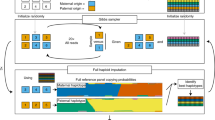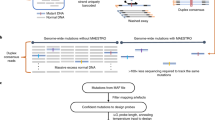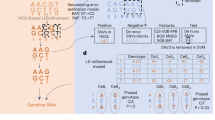Abstract
Conventional experimental methods of studying the human genome are limited by the inability to independently study the combination of alleles, or haplotype, on each of the homologous copies of the chromosomes. We developed a microfluidic device capable of separating and amplifying homologous copies of each chromosome from a single human metaphase cell. Single-nucleotide polymorphism (SNP) array analysis of amplified DNA enabled us to achieve completely deterministic, whole-genome, personal haplotypes of four individuals, including a HapMap trio with European ancestry (CEU) and an unrelated European individual. The phases of alleles were determined at ∼99.8% accuracy for up to ∼96% of all assayed SNPs. We demonstrate several practical applications, including direct observation of recombination events in a family trio, deterministic phasing of deletions in individuals and direct measurement of the human leukocyte antigen haplotypes of an individual. Our approach has potential applications in personal genomics, single-cell genomics and statistical genetics.
This is a preview of subscription content, access via your institution
Access options
Subscribe to this journal
Receive 12 print issues and online access
$209.00 per year
only $17.42 per issue
Buy this article
- Purchase on Springer Link
- Instant access to full article PDF
Prices may be subject to local taxes which are calculated during checkout





Similar content being viewed by others
Accession codes
References
Wheeler, D.A. et al. The complete genome of an individual by massively parallel DNA sequencing. Nature 452, 872–876 (2008).
Bentley, D.R. et al. Accurate whole human genome sequencing using reversible terminator chemistry. Nature 456, 53–59 (2008).
Ahn, S.M. et al. The first Korean genome sequence and analysis: full genome sequencing for a socio-ethnic group. Genome Res. 19, 1622–1629 (2009).
Kim, J.I. et al. A highly annotated whole-genome sequence of a Korean individual. Nature 460, 1011–1015 (2009).
Wang, J. et al. The diploid genome sequence of an Asian individual. Nature 456, 60–65 (2008).
Pushkarev, D., Neff, N.F. & Quake, S.R. Single-molecule sequencing of an individual human genome. Nat. Biotechnol. 27, 847–850 (2009).
Schuster, S.C. et al. Complete Khoisan and Bantu genomes from southern Africa. Nature 463, 943–947 (2010).
Petersdorf, E.W., Malkki, M., Gooley, T.A., Martin, P.J. & Guo, Z. MHC haplotype matching for unrelated hematopoietic cell transplantation. PLoS Med. 4, e8 (2007).
de Bakker, P.I. et al. A high-resolution HLA and SNP haplotype map for disease association studies in the extended human MHC. Nat. Genet. 38, 1166–1172 (2006).
Stewart, C.A. et al. Complete MHC haplotype sequencing for common disease gene mapping. Genome Res. 14, 1176–1187 (2004).
Groenendijk, M., Cantor, R.M., de Bruin, T.W. & Dallinga-Thie, G.M. The apoAI-CIII-AIV gene cluster. Atherosclerosis 157, 1–11 (2001).
Nagel, R.L. et al. The Senegal DNA haplotype is associated with the amelioration of anemia in African-American sickle cell anemia patients. Blood 77, 1371–1375 (1991).
Sun, T. et al. Haplotypes in matrix metalloproteinase gene cluster on chromosome 11q22 contribute to the risk of lung cancer development and progression. Clin. Cancer Res. 12, 7009–7017 (2006).
Drysdale, C.M. et al. Complex promoter and coding region beta 2-adrenergic receptor haplotypes alter receptor expression and predict in vivo responsiveness. Proc. Natl. Acad. Sci. USA 97, 10483–10488 (2000).
The International HapMap Consortium. A haplotype map of the human genome. Nature 437, 1299–1320 (2005).
Frazer, K.A. et al. A second generation human haplotype map of over 3.1 million SNPs. Nature 449, 851–861 (2007).
Levy, S. et al. The diploid genome sequence of an individual human. PLoS Biol. 5, e254 (2007).
Zhang, K. et al. Long-range polony haplotyping of individual human chromosome molecules. Nat. Genet. 38, 382–387 (2006).
Mitra, R.D. et al. Digital genotyping and haplotyping with polymerase colonies. Proc. Natl. Acad. Sci. USA 100, 5926–5931 (2003).
Ding, C. & Cantor, C.R. Direct molecular haplotyping of long-range genomic DNA with M1-PCR. Proc. Natl. Acad. Sci. USA 100, 7449–7453 (2003).
Michalatos-Beloin, S., Tishkoff, S.A., Bentley, K.L., Kidd, K.K. & Ruano, G. Molecular haplotyping of genetic markers 10 kb apart by allele-specific long-range PCR. Nucleic Acids Res. 24, 4841–4843 (1996).
Ruano, G., Kidd, K.K. & Stephens, J.C. Haplotype of multiple polymorphisms resolved by enzymatic amplification of single DNA molecules. Proc. Natl. Acad. Sci. USA 87, 6296–6300 (1990).
Woolley, A.T., Guillemette, C., Li Cheung, C., Housman, D.E. & Lieber, C.M. Direct haplotyping of kilobase-size DNA using carbon nanotube probes. Nat. Biotechnol. 18, 760–763 (2000).
Burgtorf, C. et al. Clone-based systematic haplotyping (CSH): a procedure for physical haplotyping of whole genomes. Genome Res. 13, 2717–2724 (2003).
Xiao, M. et al. Direct determination of haplotypes from single DNA molecules. Nat. Methods 6, 199–201 (2009).
Ma, L. et al. Direct determination of molecular haplotypes by chromosome microdissection. Nat. Methods 7, 299–301 (2010).
Douglas, J.A., Boehnke, M., Gillanders, E., Trent, J.M. & Gruber, S.B. Experimentally-derived haplotypes substantially increase the efficiency of linkage disequilibrium studies. Nat. Genet. 28, 361–364 (2001).
Marchini, J. et al. A comparison of phasing algorithms for trios and unrelated individuals. Am. J. Hum. Genet. 78, 437–450 (2006).
Ashley, E.A. et al. Clinical assessment incorporating a personal genome. Lancet 375, 1525–1535 (2010).
Bredel, M. et al. Amplification of whole tumor genomes and gene-by-gene mapping of genomic aberrations from limited sources of fresh-frozen and paraffin-embedded DNA. J. Mol. Diagn. 7, 171–182 (2005).
Marcy, Y. et al. Nanoliter reactors improve multiple displacement amplification of genomes from single cells. PLoS Genet. 3, e155 (2007).
Marcy, Y. et al. Dissecting biological “dark matter” with single-cell genetic analysis of rare and uncultivated TM7 microbes from the human mouth. Proc. Natl. Acad. Sci. USA 104, 11889–11894 (2007).
Stephens, M., Smith, N.J. & Donnelly, P. A new statistical method for haplotype reconstruction from population data. Am. J. Hum. Genet. 68, 978–989 (2001).
Stephens, M. & Donnelly, P. A comparison of Bayesian methods for haplotype reconstruction from population genotype data. Am. J. Hum. Genet. 73, 1162–1169 (2003).
Stephens, M. & Scheet, P. Accounting for decay of linkage disequilibrium in haplotype inference and missing-data imputation. Am. J. Hum. Genet. 76, 449–462 (2005).
Kukita, Y. et al. Genome-wide definitive haplotypes determined using a collection of complete hydatidiform moles. Genome Res. 15, 1511–1518 (2005).
Andres, A.M. et al. Understanding the accuracy of statistical haplotype inference with sequence data of known phase. Genet. Epidemiol. 31, 659–671 (2007).
Broman, K.W., Murray, J.C., Sheffield, V.C., White, R.L. & Weber, J.L. Comprehensive human genetic maps: individual and sex-specific variation in recombination. Am. J. Hum. Genet. 63, 861–869 (1998).
Kong, A. et al. A high-resolution recombination map of the human genome. Nat. Genet. 31, 241–247 (2002).
Frazer, K.A. et al. A second generation human haplotype map of over 3.1 million SNPs. Nature 449, 851–861 (2007).
Conrad, D.F. et al. Origins and functional impact of copy number variation in the human genome. Nature 464, 704–712 (2010).
Su, S.Y. et al. Inferring combined CNV/SNP haplotypes from genotype data. Bioinformatics 26, 1437–1445 (2010).
McCarroll, S.A. et al. Integrated detection and population-genetic analysis of SNPs and copy number variation. Nat. Genet. 40, 1166–1174 (2008).
Shiina, T., Hosomichi, K., Inoko, H. & Kulski, J.K. The HLA genomic loci map: expression, interaction, diversity and disease. J. Hum. Genet. 54, 15–39 (2009).
Guo, Z., Hood, L., Malkki, M. & Petersdorf, E.W. Long-range multilocus haplotype phasing of the MHC. Proc. Natl. Acad. Sci. USA 103, 6964–6969 (2006).
Maiers, M., Gragert, L. & Klitz, W. High-resolution HLA alleles and haplotypes in the United States population. Hum. Immunol. 68, 779–788 (2007).
Price, P. et al. The genetic basis for the association of the 8.1 ancestral haplotype (A1, B8, DR3) with multiple immunopathological diseases. Immunol. Rev. 167, 257–274 (1999).
White, R.A. III, Blainey, P.C., Fan, H.C. & Quake, S.R. Digital PCR provides sensitive and absolute calibration for high throughput sequencing. BMC Genomics 10, 116 (2009).
Tamura, K., Dudley, J., Nei, M. & Kumar, S. MEGA4: molecular evolutionary genetics analysis (MEGA) software version 4.0. Mol. Biol. Evol. 24, 1596–1599 (2007).
Acknowledgements
We thank J. Melin and the Stanford Microfluidic Foundry for fabrication of microfluidic devices. We thank N. Neff and G. Mantalas for performing sequencing experiments. We thank D. Pushkarev for providing data and primers from the genome sequencing project of P0. We thank M. Anderson and D. Tyan at Stanford Histocompatibility Laboratory for providing HLA typing results. We thank Y. Marcy, P. Blainey, J. Jiang and A. Wu for helpful discussions. The project was supported by the US National Institutes of Health (NIH) Pioneer Award and an NIH U54 award. H.C.F. was supported by a scholarship from the Siebel Foundation. J.W. was supported by a scholarship from the China Scholarship Council.
Author information
Authors and Affiliations
Contributions
H.C.F. and S.R.Q. conceived the experiments. H.C.F. designed the microfluidic device. A.P. developed protocols for device fabrication. H.C.F. and J.W. performed the experiments. H.C.F., J.W. and S.R.Q. analyzed the data and wrote the manuscript.
Corresponding author
Ethics declarations
Competing interests
S.R.Q. is a founder, consultant and shareholder of Fluidigm Corporation and Helicos Biosciences Corporation, and a consultant and shareholder of Artemis Health. H.C.F. was previously employed at Fluidigm Corporation. All other authors declare no conflict of interest.
Supplementary information
Supplementary Text and Figures
Supplementary Tables 1–6 and Supplementary Figs. 1–4 (PDF 979 kb)
Supplementary Data Set 1
Haplotypes 1 GM12891 haplotypes.txt (TXT 21809 kb)
Supplementary Data Set 2
Haplotypes 2 GM12892 haplotypes.txt (TXT 20361 kb)
Supplementary Data Set 3
Haplotypes 3 GM12878 haplotypes.txt (TXT 21341 kb)
Supplementary Data Set 4
P0 Omni1S (TXT 31433 kb)
Supplementary Data Set 5
P0 Omni1Quad (TXT 16458 kb)
Rights and permissions
About this article
Cite this article
Fan, H., Wang, J., Potanina, A. et al. Whole-genome molecular haplotyping of single cells. Nat Biotechnol 29, 51–57 (2011). https://doi.org/10.1038/nbt.1739
Received:
Accepted:
Published:
Issue Date:
DOI: https://doi.org/10.1038/nbt.1739
This article is cited by
-
Mapping crossover events of mouse meiotic recombination by restriction fragment ligation-based Refresh-seq
Cell Discovery (2024)
-
Single-Cell Sequencing Technology and Its Application in the Study of Central Nervous System Diseases
Cell Biochemistry and Biophysics (2023)
-
Chromosomal phase improves aneuploidy detection in non-invasive prenatal testing at low fetal DNA fractions
Scientific Reports (2022)
-
Isolation and sequencing of a single copy of an introgressed chromosome from a complex genome for gene and SNP identification
Theoretical and Applied Genetics (2022)
-
Microfluidics applications for high-throughput single cell sequencing
Journal of Nanobiotechnology (2021)



